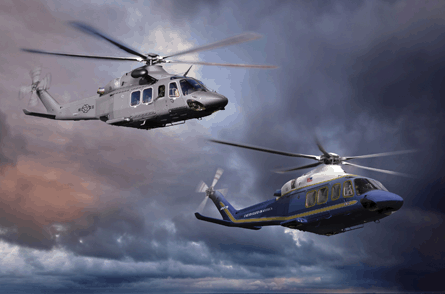Most companies brought brochures and models to the Air Warfare Symposium on 17-18 February, but AgustaWestland came with a fully armed helicopter.
With a US Air Force requirement to buy more than 90 new aircraft, the Italian manufacturer clearly hoped to send a message by unveiling the first AW139M inside the exhibit hall at the Air Force Association's second-largest public event.
"We'll be able to deliver to the air force's schedule, if not beat it," says Dan Hill, AgustaWestland North America's vice-president of strategy and federal business development.
But the AW139 and at least three other likely bidders may never get the chance to compete for the common vertical lift support platform (CVLSP) contract.
 |
|---|
© AgustaWestland |
Senior air force acquisition officials will be meeting soon to decide whether the CVLSP contract will be opened to competitive bids, or awarded on a sole-source basis to a version of the Sikorsky UH-60M Black Hawk.
Lt Gen James Kowalski, chief of Global Strike Command, strongly favours the sole-source option. Kowalski is not an acquisition authority, but his preference is important. The CVLSP will replace a fleet of Bell UH-1s protecting the air force's remote nuclear missile silos, which fall under his command.
"I can use an existing contract to purchase helicopters," Kowalski says. "It accelerates that process and maybe removes some things that, while nice to do within the acquisition formal structure, [they're not] when we're trying to do things efficiently and do things the smartest way."
The case for replacing the UH-1 is "urgent and compelling", Kowalski says, because that 1970s-era fleet has been deemed inadequate for the mission since 1996.
The air force had attempted to replace the CVLSP fleet several years ago. The programme was listed as an annex to a requirements document for the combat search and rescue (CSAR-X) helicopter.
A competition for the CSAR-X contract became a case study of breakdowns in the air force acquisition system, with two separate contract awards for the Boeing HH-47 Chinook overturned by protests and the bidding process terminated.
When the USAF relaunched the CSAR-X programme last year, service officials scaled down the requirement, allowing aircraft in the size class of the Black Hawk to compete. At the same time, Kowalski's command began pushing for a way to circumvent an acquisition process entirely, employing an obscure 1932 law called the Economy Act.
The law allows government agencies to award a sole-source contract to an existing supplier for a new requirement if there is an urgent need.
"I have had an urgent and compelling need since 1996 in terms of speed, range and payload," Kowalski says. "The UH-1 does not meet the need. How much longer are we willing to wait and take this risk?"
Sikorsky confirms that it has informed the air force that similar versions of the HH-60M Pave Hawk can perform both the CSAR-X and CVLSP roles.
In addition to the potential time savings, reducing the air force's helicopter fleet to a common platform can provide $3 billion in savings over the next 30 years, says Jim Naylor, Sikorsky's director of business development for aviation systems and a former HH-60 pilot.
AgustaWestland, however, argues that buying the AW139 would still be cheaper than buying only UH-60s.
"We're a third of the price to operate and at least half the price to acquire," Hill says, comparing the AW139M with the UH-60M.
The air force's acquisition system is undecided about circumventing a competition for CVLSP. The AW139 is not the only potential bid. The exhibit hall also included brochures for the Bell UH-1Y Super Huey and Boeing's HH-47. EADS North America officials have previously discussed a potential offer based on the Eurocopter AS332 Super Puma.
The final decision on whether to launch a competition will be made by David Van Buren, the air force's acquisition executive, and the Air Combat Command, Kowalski says. "There is still a meeting or two" left before a decision is reached, he adds.
Source: Flight International














































